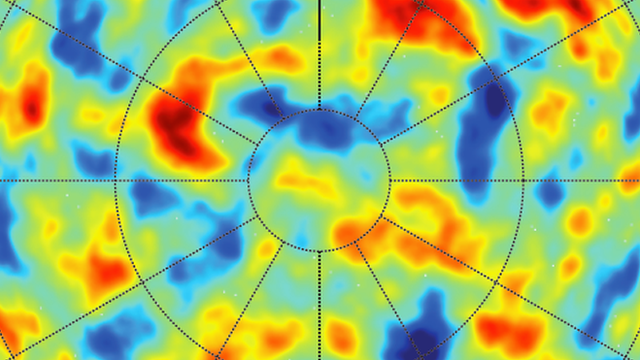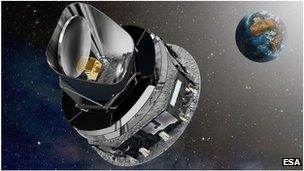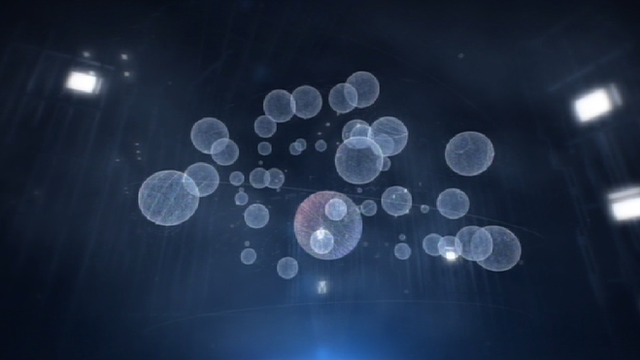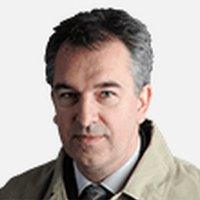Planck telescope: A map of all the 'stuff' in the cosmos
- Published
- comments

Europe's Planck telescope, which last week showed us a picture of the oldest light streaming across the Universe, has another trick up its sleeve.
It has also mapped the distribution of all the matter in the cosmos.
This was done by analysing the subtle distortions in the ancient light introduced as it passed by the matter.
The effect is a direct consequence of Einstein's theory of general relativity which tells us that space is warped by the presence of mass.
Prof Simon White, external likens it to the way light is bent as it passes through the lumpiness of an old glass window pane.
"If you know what you're looking at outside, you can use the distortions to say something about the glass," the Planck researcher said.
"There have been 'gravitational lensing' detections before over small areas, but this is the first time we've been able to do this kind of thing over the whole sky," he told BBC News.
The new map, external is a smart byproduct of the European Space Agency (Esa) telescope, external's main mission which is to survey the Cosmic Microwave Background, or CMB - a pervasive but faint glow of long-wavelength radiation that comes to us from the very edge of the observable Universe.

The Planck satellite was launched in 2009 to map the Cosmic Microwave Background
That light essentially carries a record of all the intervening structure it has encountered on its journey.
What you see in the map on this page, split across the two hemispheres of the sky, is the sum of all the matter/mass along the line of sight.
Red denotes those regions where there is more matter/mass than average; and blue denotes regions where there is less than average.
The white edging in the North/South projections is the plane of our Milky Way Galaxy.
This great mass of stars makes it impossible to discern the delicate gravitationally lensed distortions and the region is simply masked out.
The map is a very complex thing to produce, and reflects not only the extraordinary sensitivity and resolution of Planck but also the immense sophistication now possible in the statistical analysis of the telescope's data.
Scientists have checked the map against the distribution of matter obtained by other means.
In the near Universe, for example, it should fit with the detailed information we now have on the way clusters of galaxies are dotted across the sky. And it does.
For the more distant parts of the Universe, Planck itself can do the test. It can use its High Frequency Instrument, external to look for the infrared emission from dust that is warmed by stars associated with far-off galaxies.
The pattern in this light acts as a kind of proxy for the history of star formation, and therefore a history of structure in the cosmos. Again, it agrees well with what the new Planck map is telling us about the distribution of matter/mass.

Planck has now catalogued more than 1,000 big galaxy clusters - many new to science
Of course, it is thanks to Planck that we now know there is slightly more "stuff" out there than we thought, even if most of it is in a form beyond direct observation.
The analysis of the CMB data, released last Thursday, indicates that only 15.5% of the Universe's matter is what we would call "normal" - that is, the atomic material from which planets, stars and galaxies are built.
The rest (84.5%) is "dark matter" whose precise nature currently eludes scientific description.
The map at the top of this page makes no distinction. It is an integration of both normal and dark matter.
Planck can, however, be used to find a lot of previously unobserved regions of normal matter. These are large galaxy clusters.
They are identified using another clever trick named after the two Soviet physicists who proposed it in the 1960s.
Rashid Sunyaev and Yakov Zel'dovich said that a small fraction of the CMB light particles, or photons, should get a little kick in energy when they pass through the hot gas found in big clusters.
Once more, the effect is subtle but very characteristic, and Planck has used this Sunyaev-Zel'dovich method to catalogue more than 1,000 big cluster, external candidates, many of which had not previously been on the books.
"Planck is a discovery machine," the Esa project scientist Dr Jan Tauber told BBC News. "The data is now out there and people will really start to dig into it. There are a lot of scientists inside the Planck Collaboration but there are many more that are outside. They are going to find some great new uses for the data."
- Published18 March 2013
- Published27 August 2012

- Published13 January 2012

- Published3 August 2011

- Published11 January 2011
- Published27 November 2010
